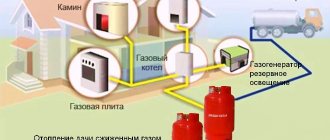You can heat a private house with solid or liquid fuel boilers, as well as with electric and gas heating equipment. Operating boilers of the first type is a rather troublesome and expensive task, because you constantly need to bring in fuel, load it into the working chamber of the boiler, and clean the chimney and boiler from ash.
Electric boilers and water heaters are easy to maintain, but consume a lot of electricity, so the home owner will have to pay considerable utility bills every month.
The most economical option is to use gas heating, because blue fuel is an inexpensive energy resource and after connecting the house to the gas main, the owner will only need to follow safety rules and carry out timely maintenance of gas appliances. This article will tell readers how to supply gas to a private home and what documents are required to collect to obtain a gasification permit.
Procedure for connecting to the gas distribution network
Consists of several stages:
- Obtaining technical specifications*;
- Submitting an application to the contractor for concluding a connection agreement and concluding an agreement;
- Carrying out connection activities, drawing up a demarcation act.
*In cases where the maximum hourly gas consumption does not exceed 300 cubic meters. meters, applicants have the right to send an application to the contractor to conclude a connection agreement without first issuing technical conditions.
Obtaining Technical Specifications for connection to the gas distribution network
Specifications can be obtained from a specialized organization. According to clause 6, the Applicant, who does not have information about the organization issuing the technical specifications, applies to the local government body with a request about the organization issuing the technical specifications.
Deadline for providing technical specifications: 14 days from the date of receipt of the application with attachments.
A request for technical specifications must contain:
- last name, first name, patronymic, place of residence and postal address;
- the planned date of commissioning of the capital construction project (if relevant information is available);
- the planned value of the maximum hourly gas (power) consumption separately for various connection points (if there are several of them) with justification for the need to connect several points. If the applicant does not have information about the planned value of the maximum hourly gas consumption, this information is clarified with the participation of the contractor’s employees when submitting a request for technical specifications or when forming it without charging a fee for a maximum hourly gas consumption of no more than 5 cubic meters. meters and for a fee with a maximum hourly gas consumption of more than 5 cubic meters. meters.
Calculation of the planned maximum hourly gas consumption can be performed by the contractor if the applicant sends a written request for calculation
- full and abbreviated (if available) names of the applicant, its legal form, location, postal address (for a legal entity) or last name, first name, patronymic, place of residence, postal address (for an individual (individual entrepreneur);
- directions of gas use, as well as characteristics of its use - the proposed heated area, the composition of gas-using equipment, other characteristics of gas use (determined by the applicant if necessary).
The following documents are attached to the request for technical specifications:
- a copy of the certificate of state registration of the right to the land plot on which the capital construction facility belonging to the applicant is located (hereinafter referred to as the land plot);
- situational plan for the location of a land plot with reference to the territory of a populated area;
- calculation of the planned maximum hourly gas consumption (not required if the planned maximum hourly gas consumption is no more than 5 cubic meters);
It is better to immediately contact the organization issuing the technical specifications so that they can provide an application form for issuing the technical specifications.
Ownership documents
If you are not the sole owner of the land plot, then consent to gasification of all adult owners is required. Your rights and the rights of other owners can be represented by third parties under a power of attorney executed in a notary's office.
If your house is connected to the gas distribution network from a neighboring plot, the consent of the owner of the plot is required. However, power assignment is possible only if the neighboring building has been connected to the same gas distribution network for at least 5 years and there are no technical contraindications to connecting a new consumer.
A land plot diagram (situation plan) can be obtained free of charge from the local administration, as well as from the BTI and from cadastral engineers, however, you will have to pay for their services. The calculation of the planned gas consumption is compiled by the contractor’s employees (GRO). If it does not exceed 5 cubic meters. m. per hour, no document is required.
What documents are needed to connect gas?
The first thing to do is find out your gas supplier. Here I advise you to just chat with your neighbors. Firstly, you will find out who the service provider is, and secondly, you can roughly estimate how much it will all cost and what “circles of hell” you will have to go through.
And now to the list, first briefly, below we will look in more detail.
- Application for gasification of a private house.
- Identity card (passport) of the owner. By the way, you can delegate the gas connection. There are even special companies that do this. To do this, you will need a power of attorney for gasification of the house, or rather for the person who will do it.
- Project for gas supply to a private house.
- Document of agreement with neighbors. Coordination with neighbors will be necessary if the gas pipeline passes through their area.
- Certificate of assignment of a postal address for gasification. The gas supply organization may not require it from you at the first stages until connection, but you are unlikely to be allowed to start gas without it.
- Certificate of ownership of land.
- Cadastral passport for land and buildings.
- Certificate of absence of animals (or their presence when keeping livestock).
- Certificate from firefighters for gas connection (form 20 gas supply).
- Gas supply agreement.
Now let's look at our points in more detail. Naturally, we will miss the obvious, such as an application for gasification (gas connection) of a private house, the owner’s passport - in my opinion, this is also obvious, etc.
Project for gas connection to a private house
You can read more about the project in our article: Project for gasification of a private house. Here we will limit ourselves to the list:
- Application to the gas supply service.
- Passport (owner's identity card).
- Technical conditions. Next, we will look at what documents are needed to obtain technical specifications. How to get them, read another article on our website: Technical conditions for connecting to gas supply networks
- Situational plan of the land plot. Read the whole article on this topic at the link: Situational plan of the land plot
- House plan with floor plan, including the arrangement of planned equipment.
Documents for obtaining technical conditions for gasification of a private house
Let us immediately clarify that at the construction stage additional documents will be needed, such as a situational and topographic plan of the land plot.
Let's return to the list of necessary documents for technical specifications:
- Application for obtaining technical specifications.
- A copy of the owner's passport or power of attorney.
- Document of ownership of the plot and the building itself (house, bathhouse, etc.) plus a cadastral passport of the object.
- Commissioning certificate.
- List of equipment located in the house and their characteristics.
- If necessary, calculate the maximum hourly gas consumption (not required if consumption is no more than 5 m³ per hour).
Memo to citizens on gasification and post-gasification
REMINDER TO THE USER
- What is the difference between gasification and post-gasification?
Additional gasification applies to the free connection of individual residential buildings owned by applicants - individuals, in settlements in which intra-village networks have already been laid, and it is required, as a rule, to complete gas pipelines to the boundaries of the land plots on which such houses are located
Gasification concerns, firstly, not only citizens, but also businesses, who must pay for it; secondly, gasification involves the construction of main and (or) inter-settlement gas pipelines, intra-settlement gas pipelines, and only then the construction of a gas pipeline to the boundaries of the applicants’ land plots .
- How do I know which program I'm getting into?
If you have documents confirming ownership of a land plot and an individual residential building located in a settlement that has already been gasified, you will be included in the additional gasification program.
Therefore, it is first necessary to register ownership of the land plot, and only then submit an application for additional gasification.
Houses located in non-gasified settlements are included in the regional gasification program in order to create conditions for gasification without the use of citizens' funds.
If the home ownership is located within the boundaries of horticultural or vegetable gardening non-profit partnerships (hereinafter referred to as SNT), and the SNT itself is located within the boundaries of a gasified settlement, bringing the gas pipeline to the boundaries of such SNT will be free. Within the boundaries of the SNT, citizens independently carry out the construction of a gas distribution network (with the involvement of a gas distribution organization or other construction organization). Subsequently, the connection of households is carried out only by the gas distribution organization; the cost of connection will continue to be regulated by the state.
- What level of gasification is the target? Why is this not 100%?
President of the Russian Federation V.V. Putin (instruction No. Pr-907 dated May 31, 2020) set the goal of ensuring the gradual completion of gasification in Russia by 2024 and by 2030.
In accordance with the current fuel and energy balances of the regions, the potential level of gasification is estimated at 82.9%.
When determining the level of potential gasification, dilapidated and dilapidated housing stock that is not subject to gasification, as well as apartments or households provided with: electric stoves, autonomous and centralized hot water supply, autonomous and centralized heating, are not taken into account.
- What are fuel and energy balances (TEB)? Why should I care?
The fuel and energy balances of the regions should take into account the forecast levels of energy consumption, taking into account the development prospects of the regions, as well as the possibility of using alternative sources of gas (liquefied natural or hydrocarbon gas) or other types of fuel. Such balances will make it possible, in particular, to comprehensively forecast the demand for gas and other energy resources and ensure a balance in all energy sectors.
The fuel and energy balance will make it possible to assess the prospects of converting certain settlements to gas from other energy sources.
- How much does “free gasification” cost?
a. How much does it cost to connect to (land boundary)?
If you are an individual who, on the basis of ownership or other legal basis, has an individual residential building within the boundaries of a gasified settlement and intends to use gas to satisfy personal, family, household and other needs not related to business (professional) activities, then the cost of technological connection for you is zero.
b. How much does it cost to install gas inside the site?
This depends on the scope of work on the construction of the gas pipeline inside the land plot, on the method of laying the gas pipeline. At the same time, if you have made a decision on gasification within the boundaries of the land plot by a gas distribution organization, then the cost of such services is regulated by the state; if you use a third-party organization, then the services are provided on a contractual basis.
c. What about in-house gas equipment?
The cost of in-house gas equipment (stove, boiler, water heater, etc.) and the cost of its installation depends on the power, brand of the equipment manufacturer, as well as on the wishes of the applicant and is purchased additionally. Gas distribution organizations will help you select equipment.
- How to avoid being scammed when connecting?
Today, connections (technological connection) are carried out only by gas distribution organizations, whose activities are regulated by the state. If gas distribution organizations violate the terms of the connection agreement or receive an unreasonable refusal to connect, it is advisable to contact the Federal Antimonopoly Service.
- What do I need to do to get gas?
First of all, you need to submit an application, for this you can use the website of the gas distribution organization or come to one of the centers (offices) of the gas distribution organization, from September of this year it will be possible to submit an application through the portal of State Services, MFC, or using the single portal of the single gasification operator SOCGAZ .RF.
- I submitted an application - when will I get gas?
The contract will indicate deadlines for connection, depending on the length of the gas pipeline that the gas distribution organization needs to build to the border of your land plot. The connection period also takes into account the time required to carry out activities within the boundaries of your land plot, namely: laying a gas consumption network, internal gas pipeline through the house, installation of gas-using equipment.
- Can I be rejected after I have submitted an application?
They may if you do not submit a complete set of documents or the data is filled in incorrectly.
Also, if the connection parameters of your individual residential building do not meet the criteria, namely, the house is not registered or is located in a non-gasified locality.
- How much will gas cost? Are there hidden fees for using gas?
The cost of gas supply is regulated by the state and is set for citizens by regional authorities depending on the direction of gas use (food preparation, hot water supply, heating).
There are no hidden fees; after connection there will be additional costs for maintenance of in-house gas-using equipment necessary to ensure safe operation.
- Will the tariff increase?
Tariffs increase only in accordance with inflation; there will be no additional increase for citizens due to connection.
- How to apply for additional gasification?
a. Where to contact?
You can go to the website of the gas distribution organization or come to one of the centers (offices) of the gas distribution organization, and from August of this year it will be possible to submit an application for free gasification through the portals of State Services, MFC, or a single gasification operator - SOCGAZ.RF.
b. What documents are needed?
Title documents for a land plot and an individual residential building, situation plan, passport, SNILS and contact information. A standard application form with a list of required documents will be available to you on the websites or offices of gas distribution organizations.
c. What are the criteria for compliance with post-gasification?
If your individual residential house and land plot are registered in the prescribed manner, and the house is located in a settlement that has already been gasified, you will be included in the accelerated social gasification (pre-gasification) program.
- If I submitted an application in March or May, am I eligible for free additional gasification?
The conditions for free additional gasification apply to cases of filing an application and concluding a connection agreement starting from April 21, 2022. So, if the connection agreement was concluded after April 21, 2022, and you made payment, then you can contact the gas distribution organization to conclude an additional agreement on the free provision of connection services. In this case, the money paid will be returned to you, but the term of the connection agreement may be adjusted.
If the connection agreement is concluded before April 21, 2021, the gas distribution organization will not refund the money paid (in whole or in part). At the same time, you have the right to terminate the connection agreement, not pay the remaining part of the fee, and submit a new application for free additional gasification.
- I still have questions. Who can I discuss them with?
The single gasification operator and regional gasification operators must not only organize the construction of gas pipelines, but also communicate with citizens by organizing a hotline, creating the technical ability to submit questions and answer them online by specialists on their official websites. Regional headquarters responsible for coordinating the activities of operators will be formed in each subject. You can also contact the gas distribution organization with any questions you may have.
- What are EOG and ROGA?
The Unified Gasification Operator (UOG), which, in essence, will become a single center of responsibility for gasification issues and for ensuring free connection of households to gas distribution networks.
A regional gasification operator (RGO) is a company that is the same center of responsibility as the EOG, in the territory of the subject where its networks are larger than that of the EOG.
Based on materials from the site: rossoshen.ru
Help form 20
Let's look at the information on the certificate from the fire service, form 20, in more detail. Let's start with the fact that the Form 20 act for gas supply means an initial check of the chimney and ventilation.
In general, the frequency of inspection has been established, for example, twice a year for seasonal use of gas boilers and, accordingly, ventilation ducts. However, the certificate will only be needed once when connecting. For example, the photo below shows the same act of Form 20 (form).
Boiler room in the house
The list of equipment used is determined not only by the requirements of various rules and regulations. But also the wishes of the owner. Most often there is a choice between a boiler and a convector. Each option has its own advantages and features. You need to choose based on the area of the house and other factors. A power calculation is preliminarily performed. There are additional costs - you will need to install a heat exchanger and chimney.
Boiler or convector?
Designing a gas pipeline in a private house must begin with the selection of equipment. The boiler is more functional and versatile. With its help, you can heat a large area with sufficient power, and it is easier to operate. In turn, the convector is well suited for a room without partitions. For example, it could be a garage or something similar. The boiler is suitable for a multi-storey building. Convector – for a small one-story building. The operating principle of the latter is somewhat simpler. Which makes its cost lower.
Types of boilers and convectors
For a private home, you need to purchase boilers from well-known and well-established manufacturers. Most often the choice is between the following types:
- single-circuit - used only for heating living space;
- double-circuit - allows you not only to supply the house with heat, but also to provide hot water supply.
The second type is an order of magnitude more expensive than the single-circuit one. You need to choose a specific one based on the needs of the owner. Convectors are divided into categories depending on the material from which the heat exchanger is made:
- cast iron;
- steel.
Steel ones are more affordable at their price. But their service life is an order of magnitude shorter than cast iron.
Power calculation and additional equipment
The calculation for a standard project (with a height from floor to ceiling of no more than 300 cm) is simple, performed in two steps:
MK = S*YMK/10,
- MK – power area, kW;
- S – heated quadrature;
- YMK – indicates specific power (per 10 m2).
The YMK parameter is determined based on climate zone data:
- south of the Russian Federation – 700-900 W;
- middle band – 1000-1200 W;
- Moscow region - 1200-1500 W;
- northern regions - 1500-2000 W.
It is important to remember that this calculation applies only to single-circuit boilers. If there is a need to heat water for domestic needs, a power reserve of 25% of the result obtained is required (or more, if possible). For a convector, the power calculation will be different:
room volume × 0.04 = recommended heating power
0.04 is 40 W per 1 m3 of heated area. In addition to the boiler or convector, additional equipment will be needed. These are heat exchangers, chimneys and expansion tanks (if the system is double-circuit). In each case, the calculation is individual.
What is the MX-20 uniform?
MX-20 is a unified form of reporting on the movement of inventory items in the places where they are stored. The report is submitted to the accounting department by the financially responsible person (MRO) after the established reporting period. The form of this document was approved by Decree of the State Statistics Committee dated 08/09/1999 No. 66.
The report, drawn up in the MX-20 form, indicates, in particular:
- names of goods and materials;
- assortment, quantitative indicators of goods and materials;
- accounting prices of specific inventory items;
Entries in this report are made in correlation with each primary receipt and expense document, as well as taking into account inventory balances.
The document is signed by the MOL, and then by an accountant who certifies that the form has been verified.
How many copies of form MX-20 are needed is determined based on the accounting policies of a particular business entity. Similarly, at the internal document level, the completeness of the report is established. Thus, the accounting department may oblige the MOL to supplement the report on the movement of inventory items with other supporting documents. In this case, information about their number is indicated in the “Appendix” column of the MX-20 form.
The report form on the movement of inventory items in the MX-20 form is available for download on our website.
Download form MX-20
You can also download a completed sample of this form.
What objects can be gasified?
Law No. 69-FZ allows only capital construction projects to be connected to the gas distribution network. These include:
- industrial buildings, structures and structures;
- private and apartment buildings put into operation;
- objects whose construction has not been completed.
Consequently, it is possible to begin supplying gas to the site even before the construction of the house begins. In this case, the connection of gas equipment and the actual start-up of gas will be carried out after the house is put into operation.
The list of objects that you cannot connect to gas is given in Russian Government Decree No. 549:
- non-permanent buildings and structures - outbuildings, greenhouses, garages and bathhouses without a foundation, summer kitchens and other similar objects;
- inseparable improvements to the land plot - covering, paving, path, sidewalk;
- separate apartments in an apartment building (gas is connected to the whole house, and not to each apartment separately).
Country or garden houses can be gasified if they are classified as capital construction projects, that is, they stand on a foundation and are registered in the Unified State Register of Real Estate.
What should be included in the project
Drawing up gasification projects begins with initial data. Design work is carried out using water and gas supply technology.
A specialist goes to the site, collects the necessary information, and takes distance measurements:
- from the gas supply source to the walls of the house;
- between structures, outbuildings that are located on the property of the owners and neighbors.
Design includes preparation of the following technical documentation:
- gasification plan for the site, it is possible to lay the pipe above ground and underground before entering the house;
- diagrams with fuel connection points, placement of equipment with the floor plan of the house, including the basement floor, where boiler rooms are often located;
- fire safety regulations indicating valve locations, pressure at the inlet and outlet of the frequency flue in MPa.
The house plan indicates gasified areas, gas equipment connection points, taking into account the wishes of the customer and compliance with the requirements for the facility to ensure fire safety.
Read more: Gasification of a dacha and What to do if the gas is turned off
Technical conditions for gasification of a residential building
A request for technical specifications is also submitted to the gas distribution service. They cannot refuse to accept an application for the provision of technical specifications if gasification is permitted by law and the applicant has submitted all the required documents. The examination will be carried out within the established time frame.
The basis for refusal to issue a document on technical specifications may be the lack of possibility of technological connection. In this case, the contractor must notify the customer about the approximate timing of such an opportunity. If the contractor unreasonably refuses to issue the technical specifications document, the customer may file a claim in court to force the issuance of the necessary documents and compensation for damage caused by such refusal.
The technical specifications document indicates the following parameters:
- maximum gas flow (m3/hour);
- name of the property;
- timing of connecting the house to the gas distribution main;
- characteristics of the network at the connection point;
- validity period of the technical specifications.
The calculation takes into account the area of the house, as well as the technical characteristics of heating and water heating equipment. When developing specifications, the throughput of the gas main and the number of connection points are taken into account. The connection point is the place where the gas consumption network is connected to the gas main.
Connection point of the house to the central gas system
According to the established regulations, the house must be connected at one point. If there are two residential buildings on the site, it is possible to connect each house separately.
The technical specifications document is valid for 70 days, excluding weekends, unless the date of its validity is indicated. During this time, you need to have time to develop a gasification project and conclude a connection agreement. If you do not meet this time, you will have to re-conduct a technical examination and draw up a report.
Required Documentation
To consider an application for technological connection of a residential building to the gas distribution network at the gas distribution organization (GRO), you need to collect the following documentation:
- documents confirming the applicant’s ownership of the house and land;
- a document confirming the compliance of the technical conditions of the house with the gas distribution network (TU);
- copy of passport;
- diagram of the land plot and adjacent territory;
- calculation of planned gas consumption;
- gasification project.
The application also indicates the location of the house that needs to be connected to the gas main, the applicant’s passport details and postal address, email address or telephone number for contact. The application can be submitted in electronic format on the GRO website, sent by mail or at the document acceptance center of the gas distribution organization. For the unreliability of documents attached by the applicant in electronic format, the legislation provides for administrative liability. The address of the GRO can be found in local authorities or found on the Internet, indicating the name of the subject of the Russian Federation.
Stages of gasification at home
The Contractor reviews the application within three days from the date of receipt. If the applicant has not fulfilled all the requirements, he is notified that he must provide all missing information and documents within 20 days. Consideration of the application is suspended at this time.
Gasification process step by step
Let's take a step-by-step look at the procedure for connecting gas to a private home and what the owner of the house needs to do to ensure that blue fuel gets into his home and makes life more comfortable.
- Selecting the type of gas supply. If the residential heated area of the house does not exceed 250 sq.m., then fuel consumption is planned to be no more than 5 cubic meters per hour. This option falls into the first group and is the most popular for private housing.
- Drawing up draft technical specifications for gas. To do this, you will need to contact local gas workers with a number of documents. The application will be reviewed within a month and connection is possible only if the house is located near the main gas pipe (no more than 200 meters).
- Technical connection to the main line. Upon positive consideration of all submitted documents, a technical connection to the gas main is carried out. This is carried out only by specialists from the relevant service. The cost of the work directly depends on the distance of the house from the installation site and the complexity of the installation; it ranges from 25-50 thousand rubles.
- Home gasification project. Perhaps the most expensive procedure in the entire process. The project must take into account all equipment that will operate using blue fuel. The location in the premises of each device and the chimney are also indicated here. The cost of the project preparation service is quite high if you contact a private design bureau, but the time frame there is minimal. A project ordered from the city gas service costs much less, but then you will have to come to terms with the deadlines, which range from 3 to 6 months.
- Installation work. Direct installation of gas equipment should be entrusted only to competent specialists. Be sure to sign a contract with them to complete all work.
- Gas connection. Compliance with all conditions for installation and safe operation of gas equipment before connection is necessarily checked by gas workers on site. An application is made for this, and the wait is on average 2 weeks. The verification is confirmed by a receipt, with which you need to contact the gas service and wait for the conclusion of an agreement. At the same time, specialists go to the site, seal the meter and provide instructions on the safety of using gas equipment.
The distance of the house from the highway by more than 200 meters makes it almost impossible to connect it. After all, it will cost a decent amount to supply gas to one house. Alternatively, if several houses are located remotely, you can reach an agreement with their owners and submit an application to the gas service. If this is an entire village where there are a large number of houses wishing to connect to the gas pipeline, then it is possible to consider this issue and supply an additional pipe to the populated area free of charge.
Gasification project
Project documentation is drawn up based on information about the specifications. The list of documents includes the following information:
- the place where the gas pipe enters a private house;
- distribution of communications throughout the facility and inside the house;
- list of necessary work when connecting;
- security measures;
- work estimates;
- recommendations on the technical characteristics of gas equipment.
Gasification project for a private house
To develop design documents, the designer takes the necessary measurements on site, taking into account the customer’s wishes regarding the location of gas appliances. The gasification project can be drawn up by specialists from the gas distribution company, but the law provides for the possibility of engaging third-party companies to develop the project, but their services will be more expensive. However, in this case the documentation will be compiled faster. When contacting a third-party design organization, you need to check that it has a license to carry out this work.
Previously, a project for gas distribution throughout the house was needed only for buildings of 3 floors or higher with 1 family living. However, according to SP 402.1325800.2018, from 06/06/2019, the gas supply project will become mandatory in other cases when connecting to gas.
Why are technical specifications for gas required?
Technical conditions for connecting to gas are developed for each building individually. They are calculated, first of all, for the subscriber’s safe use of gas networks. Therefore, the document contains the necessary conditions, requirements for the design of the gas pipeline and its installation parts, for the chemical composition of the fuel and its technical parameters, to limit the impact on the environment. Due to the fact that consumers need gas for various purposes (installation of a gas boiler for heating a house, additional floor heating and hot water supply, for a kitchen stove, or all together), the specifications will differ.
Attention! After receiving technical conditions for gas connection, the subscriber can contact the design organization to draw up a project for the connected system, without which it is impossible to build a new gas pipeline.
Necessity of design
Ensuring a safe and uninterrupted supply of gas to a residential area is an important and primary task for engineers when implementing a project for gas systems in a private home. To do this, you need to comply with a number of norms and rules found in special reference books, state standards and SNiPs. Special design organizations are engaged in the design of gas equipment. The designer must take into account all the nuances from gas toxicity to equipment installation. The project is the basis of the process of gas supply to the house and you need to start with it, and after the project is approved by the gas service, it becomes possible to install the gas system.
Where are the technical conditions for connecting to the gas network issued?
Technical conditions for gasification of a building are obtained from the company at the site of construction, which operates the gas distribution networks closest to it. If this is a regional center of Russia, then to the local “Oblgaz”. For districts of this region, you must contact Raygazy, branches of the regional company.
The owner of a gasification facility must take certain steps to obtain technical conditions (according to Resolution No. 82, paragraph 3):
- Write an application to the State Distribution Organization for the provision of technical conditions for gas connection or an application for concluding an agreement on connection to the system in accordance with the forms provided for by regulations. In the request, at the request of the subscriber, you can add a request to provide data on the amount of payment for joining the GDS (clause 13-1 of Resolution No. 82).
- If it is impossible to connect a building to the gas system due to a ban on its gasification, according to the legislation of the Russian Federation, or the owner does not provide all the necessary papers, the gas company is obliged, within 3 days from the time the application was accepted, to return it to the applicant along with the provided papers.
- The subscriber may request preliminary technical conditions (they indicate general information and hourly fuel consumption), but their validity extends only to 70 days.
For your information! The gas distribution company must make technical conditions for connection to the gas distribution system within 14 days, if there are no legal obstacles to connecting the structure to the gas distribution system.
How to order a gas supply project for a private house
You can apply for gasification design to your local gas supply organization or any other gas company that has the appropriate licenses. A gas company can offer the following services:
- Examination of documents
- Development of a project for internal gas equipment and external gas supply of the house and its subsequent examination;
- Author's supervision of installation on site
In every locality there are authorized organizations that provide services for the design of gasification of any objects: boiler houses, gas pipelines, private houses. All of them are members of self-regulatory organizations (SROs). The structures of self-regulatory organizations ensure that all gas supply work is carried out legally and competently. Poorly performed work or failure to fulfill the terms of the contract entails a loss of the company’s reputation and incurs losses. The qualifications of specialists are constantly checked, every three years, by an authorized commission. It is important that measurements, site visits, approvals and approval of the project are in the same hands. In case of poor quality of the project, the owner of a private house can file a claim regarding the work of the design engineers and redo the project.
Regulatory acts for home gasification
During the gasification process, you will have to deal with the following regulations:
- Federal Law of March 31, 1999 No. 69-FZ “On Gas Supply in the Russian Federation”;
- Decree of the Government of the Russian Federation dated July 21, 2008 No. 549 “On the procedure for supplying gas to meet the household needs of citizens”;
- Decree of the Government of the Russian Federation dated December 30, 2013 No. 1314 “On approval of the Rules for connecting facilities to gas distribution networks”;
- Decree of the Government of the Russian Federation dated June 15, 2017 No. 713, which approved the forms of requests (applications) for connection;
- GOST R 54961-2012 “Gas distribution systems. Gas consumption networks.”
According to Federal Law No. 69-FZ, gas connection includes organizational and technical actions, i.e. paperwork and construction and installation work. The procedure for connecting and supplying gas to the population has been approved at the federal level. Local authorities or gas companies cannot set their own rules or require additional documents.
Gas connection to a private home in 2022
Russian President Vladimir Putin instructs the Russian government, gas services, and all relevant services to make connecting all households in Russia to gas networks free of charge.
“Now, if a village gas pipeline runs along the street, then the owner of a residential building must pay for [laying a pipe] from the gas pipeline directly to the land plot. The load will be removed from this section, called the last mile, and we will prepare changes in legislation that will allow us not to pay from the gas pipeline to the boundaries of the land plot or fence,” he noted.
Novak emphasized that already inside the site the owner needs to independently provide a gas connection. “This is his property, this is his territory, and there will be no need to pay before the fence,” the Deputy Prime Minister explained to reporters.
This innovation will affect tens of thousands of households across the country. Thus, Russia will soon face large-scale gasification of private households.
The head of state also instructed the government and regions to develop a plan for gasification of households.
Requirements for gasified premises
When developing an autonomous gasification project, regulatory regulations are strictly observed. Experts scrupulously check every point of the submitted design and estimate documentation.
Based on the conditions of construction of the frequency house, the methods of laying the pipeline through which gas will flow into the home, the type of connected equipment, the requirements for gas networks are determined. If at least one of the requirements and rules is not met, the project documents are returned for revision. Employees of the technical department of gas services carefully check the documentation.
The following rules have been developed for residential private buildings:
- within the walls of one residential premises it is allowed to install two boilers (main and backup);
- as a rule, gas equipment is placed in a separate, dedicated technical room (boiler room), located on the ground floor of the building;
- installed gas appliances for providing hot water supply, heating and cooking, as well as gas meters must have a passport or other document from the manufacturer;
- home appliances, boilers are connected using a flexible or conventional pipeline made of stainless steel or other approved materials that ensure a safe supply of natural fuel. The recommended maximum length of hoses is 1.5 m;
- at facilities with installed gas equipment, it is planned to install a gas metering unit (this is a gas meter, sensors for measuring pressure, temperature sensors, etc.);
- The taps that shut off the supply of blue fuel to the device are isolated from the flexible pipeline with a special dielectric insert.
If materials with a high flammability class are used near gas boilers and stoves, then they must be lined with non-combustible thermal insulation; The boiler room should be equipped with hinged windows that can be quickly opened in case of an emergency.
The minimum dimensions of the kitchen where the gas stove is located have been determined: the ceiling must be at least 2.2 m high, the windows must be easy to open, and a small space must be left from the bottom of the door to the floor for through air exchange. Currently, it is mandatory to place a special device for determining gas leaks of the “gas control” type in the gas supply room.
If a gas stove is installed in the kitchen, then the volume of the room should be:
- with 2 burners - at least 8 cubic meters. meters;
- 3 – 12;
- 4 – 15.
There must be at least one meter of distance between the gas stove and the opposite wall.
Does the state gasification program provide benefits?
The state gasification program is aimed at improving the standard of living in villages and other populated areas.
The general principle is this: at the expense of the state, gasification of streets takes place (that is, a gas pipe is stretched along the street), and the owners of housing (plots) themselves pay for the gas supply to their homes. This turns out to be much cheaper than installing gas from scratch, but there is a big drawback: the populated area must be included in the state program. And even if you are lucky and get on the list, you will have to wait your turn, and this could be years.
Gas saving
The cost of blue fuel is steadily increasing every year. Many owners achieve savings using the following methods:
- to save hot water, you need to use a shower rather than a bath - this will reduce heating costs (less liquid is required);
- installation of a double-circuit boiler;
- thermal insulation – by maintaining heat in the house, you will not need to spend a lot of fuel;
- installing double-glazed windows - this will reduce heat escaping from the room;
- it is important to pay attention to pipe routing - if done correctly, it will reduce consumption by 10-15%;
- installation of controlled heating - manual temperature adjustment;
- installation of the meter.
The correct selection of heating equipment affects not only safety. But also on the consumption of blue fuel. If you install a low-power boiler, the consumption will decrease. At the same time, it will be impossible to maintain a comfortable temperature. If the boiler is too powerful, the consumption will increase. It is important to approach the design correctly. Therefore, it is important that a competent employee does this. Incorrectly designed heating pipes and incorrectly selected equipment lead to serious losses.
How much does it cost to connect to a gas pipeline?
There is a federal law “On State Regulation of Gas Prices” No. 1021 dated December 29, 200. It establishes certain restrictions on the cost of connecting gas to a private home.
For example, it states that the cost of gas connection cannot be less than 20,000 and more than 500,000 rubles.
But subject to a number of conditions:
- Gas consumption does not exceed 15 m³ per hour during the day and 5 m³ per hour at night.
- The distance from gas-using equipment to distribution networks in a straight line is no more than 200 m.
- Design operating pressure of the network is not more than 0.3 MPa
- Connection activities do not involve the construction of facilities other than gas pipeline inlets.
Advice! If the distance is more than 200 meters, residents of the locality can create a public organization in order to achieve the connection of the gas main to their houses. As we already wrote, it is expensive, but convenient for everyone and allows you to share costs.
Often, a connection agreement involves breaking up the payment into several stages.
Installation of a gas pipeline to a private house
The connection fee obliges the contractor to bring the gas distribution network to the connection point and prepare the facility for gas start-up no later than the deadlines established by the contract. Distribution of communications around the site and inside the applicant’s house is paid separately. If this work is carried out by specialists from a gas distribution organization, then their cost will be calculated according to tariff rates. To save time for carrying out work within the boundaries of the site and inside a permanent structure, third-party companies can be hired. In this case, payment is calculated at market prices.
Installation of a meter when introducing gas into the house from outside
If a gas distribution network is laid to the border of the site, installation work to supply gas to a private house for citizens of the first category must begin no later than 9 months after payment for the technological connection. Connecting the house to the gas pipeline must be completed within 10 days from the start of work.
The final stage of installation work is installing the meter, connecting gas appliances, checking the system for possible leaks, checking ventilation and testing the gas. This work can only be carried out by GRO employees. After this, a certificate of readiness is signed, the owner of the house receives a technical inspection receipt, and the documents are again sent to the gas distribution organization. Within three weeks, city gas workers must come and seal the gas meter. Then a gas supply agreement is concluded with the consumer and the capital structure is included in the gas supply system. These relations are regulated by Government Decree No. 549.
Insertion into the central gas pipeline to connect a residential building
Termination of contracts
The subscriber has the right to terminate the gas supply contract unilaterally at any time, provided that he has fully paid the gas supplier for the consumed gas and the costs associated with the work to disconnect the in-house gas equipment from the gas distribution (connected) network.
Expenses incurred in connection with the work to disconnect in-house gas equipment are paid to the gas supplier, unless otherwise provided by the agreement on maintenance of in-house gas equipment concluded by the subscriber with a specialized organization.
The contract is recognized as terminated from the day the in-house gas equipment is disconnected from the gas distribution (connected) network, which is confirmed by the act of disconnecting the in-house gas equipment from the gas distribution (connected) network, signed by the parties with the obligatory indication of the date of disconnection.
The gas supply agreement may be terminated by mutual agreement of the parties from a date determined by the parties.
Consider an underground gas pipeline
It is more expensive to build a gas pipeline underground than above ground (approximately 60%). But he does not lose his popularity. The explanation for this is quite logical - such pipes have the greatest protection compared to above-ground ones and have a longer service life. They are less dangerous for the environment.
It should be taken into account that when laying an underground gas pipeline, either partial restriction of traffic on a separate section of the road or complete blocking of traffic is required. For this purpose, the necessary diagrams are drawn up by the installation organization. The next stage will be coordination with the traffic police department of a scheme for restricting traffic and blocking the places where work on laying the gas pipeline will be carried out. After completing the approval procedure, a warrant is issued to perform this type of work.
Some nuances of gasification
After receiving the technical conditions for connecting to the gas distribution system, it is better to order a connection project from the company that the State Distribution System will recommend to you. This way it will be approved faster.
When choosing a storage facility for liquefied gas, you should look at all warranty papers and choose products made of high-quality metal (cheap products may have imperfections in the surface of the container and its fastenings). Do the installation strictly according to the instructions, hiring good specialists.
Sources
- https://primelegal.ru/konsultacii/poryadok-podklucheniya-k-gazosnabzheniyu/
- https://domsgazom.ru/podklyuchenie-gaza/kakie-dokumenty-nuzhny-dlya-podklyucheniya-gaza
- https://nalog-nalog.ru/buhgalterskij_uchet/dokumenty_buhgalterskogo_ucheta/unificirovannaya_forma_mh20_blank_i_obrazec/
- https://santehnik-ryadom.ru/gazifikacziya/oformlenie-gazovyh-dokumentov-perech
- https://stroychik.ru/otoplenie/gazifikaciya-chastnogo-doma
- https://comfort-invest.ru/granicy/gaz-do-granicy-uchastka-besplatno-2019-god.html
- https://tabor-kids.ru/zhile/tehusloviya-na-gazosnabzhenie-chastnogo-doma.html
- https://www.markint.ru/zakon-o-gazifikatsii-rf-na-2020-2021-god-komu-provedut-gaz-besplatno-vazhnye-novosti-segodnya/
- https://vseobankah.ru/novosti/5063-besplatnoe-podkljuchenie-gaza-v-2021-godu.html
- https://roscontrol.com/ozpp/article/kak-provesti-gaz-v-zagorodniy-dom-v-2018-godu/
- https://mrgdv.ru/fizicheskim-licam/poryadok-zaklyucheniya-dogovora-postavki-gaza/











